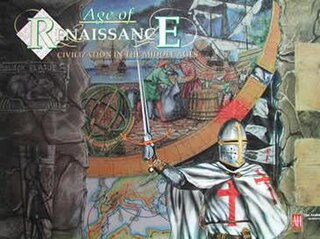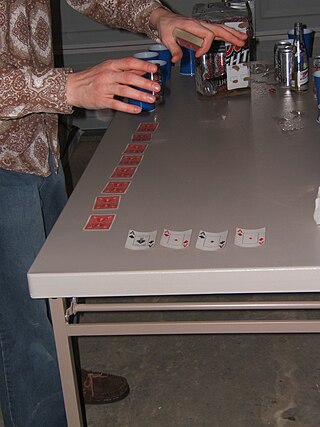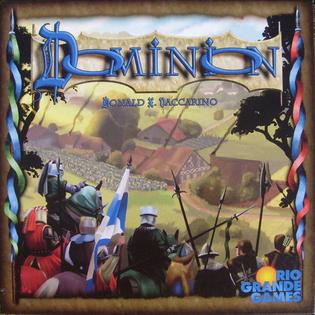
Blackjack is a casino banking game. It is the most widely played casino banking game in the world. It uses decks of 52 cards and descends from a global family of casino banking games known as Twenty-One. This family of card games also includes the European games Vingt-et-Un and Pontoon, and the Russian game Ochko. Blackjack players do not compete against each other. The game is a comparing card game where each player competes against the dealer.

Texas hold 'em is one of the most popular variants of the card game of poker. Two cards, known as hole cards, are dealt face down to each player, and then five community cards are dealt face up in three stages. The stages consist of a series of three cards, later an additional single card, and a final card. Each player seeks the best five card poker hand from any combination of the seven cards; the five community cards and their two hole cards. Players have betting options to check, call, raise, or fold. Rounds of betting take place before the flop is dealt and after each subsequent deal. The player who has the best hand and has not folded by the end of all betting rounds wins all of the money bet for the hand, known as the pot. In certain situations, a "split-pot" or "tie" can occur when two players have hands of equivalent value. This is also called a "chop-pot". Texas hold 'em is also the H game featured in HORSE and in HOSE.

Brag is an 18th century British card game, and the British national representative of the vying or "bluffing" family of gambling games. It is a descendant of the Elizabethan game of Primero and one of the several ancestors to poker, the modern version just varying in betting style and hand rankings. It has been described as the "longest-standing British representative of the Poker family."

Card counting is a blackjack strategy used to determine whether the player or the dealer has an advantage on the next hand. Card counters are advantage players who try to overcome the casino house edge by keeping a running count of high and low valued cards dealt. They generally bet more when they have an advantage and less when the dealer has an advantage. They also change playing decisions based on the composition of the deck.

The Wheel of Time: Collectible Card Game was a collectible card game based on Robert Jordan's The Wheel of Time fantasy series, published by Precedence Entertainment in December 1999. The Wheel of Time was somewhat unusual among contemporary CCG's, because the game required a play mat with tokens and customised six-sided dice to play it. It uses some similar game mechanics to the Babylon 5 Collectible Card Game and the Tomb Raider Collectible Card Game, which were also published by Precedence.

Age of Renaissance is a board game designed by Don Greenwood and Jared Scarborough and published by Avalon Hill in 1996. The game is for 3-6 players and the box claims that the game should take 2-6 hours to play, though as with any serious multiplayer strategy game, this can entirely depend on the players. Age of Renaissance is set in the European Renaissance historical era and is somewhat of a sequel to Civilization. In 1997, Age of Renaissance won the Origins Award for Best Pre-20th Century Board Game of 1996.
History of the World is a board game designed by Ragnar Brothers and originally published in 1991. It is played by up to six players in seven epochs, each player playing a different empire in each epoch.

Handicapping, in sport and games, is the practice of assigning advantage through scoring compensation or other advantage given to different contestants to equalize the chances of winning. The word also applies to the various methods by which the advantage is calculated. In principle, a more experienced participant is disadvantaged, or a less experienced or capable participant is advantaged, in order to make it possible for the less experienced participant to win whilst maintaining fairness. Handicapping is used in scoring many games and competitive sports, including go, shogi, chess, croquet, golf, bowling, polo, basketball, and track and field events. Handicap races are common in clubs which encourage all levels of participants, such as swimming or in cycling clubs and sailing clubs, or which allow participants with a variety of standards of equipment. Often races, contests or tournaments where this practice is competitively employed are known as Handicaps.

Caylus is a strategy oriented, German-style board game designed by William Attia and independently published in 2005 by Ystari in France and England, and Rio Grande Games in North America. Caylus has a mix of building, producing, planning, and bargaining — without direct conflict or dice-rolling mechanics.

Horserace is a drinking game using playing cards that is inspired by horse racing. Participants bet amounts of alcohol on one of four aces, much like bettors would bet money on horses at a racing track. The game requires a standard deck of playing cards.

Dominion is a card game created by Donald X. Vaccarino and published by Rio Grande Games. It was the first deck-building game, and inspired a genre of games building on its central mechanic. Each player begins with a small deck of cards, which they improve by purchasing cards from a common supply that varies from game to game. Cards can help the player's deck function, impede their opponents, or provide victory points. As of December 2022, fifteen expansions to the original Dominion have been released.

Race for the Galaxy is a card game designed by Thomas Lehmann. It was released in 2007 by Rio Grande Games. Its theme is to build galactic civilizations via game cards that represent worlds or technical and social developments. It accommodates two to four players by default although expansions allow for up to six players, as well as solo play. The game uses iconography in place of language in some places, with complex powers also having a text description. While appreciated by experienced players for being concise, some new players find the icons difficult to learn and to decipher.
The following is a glossary of poker terms used in the card game of poker. It supplements the glossary of card game terms. Besides the terms listed here, there are thousands of common and uncommon poker slang terms. This is not intended to be a formal dictionary; precise usage details and multiple closely related senses are omitted here in favor of concise treatment of the basics.
Glossary of North American horse racing:

Las Vegas is a board game designed by Rüdiger Dorn and published by Ravensburger in 2012. It is named after the city of Las Vegas in Nevada, United States and has a gambling theme. The game was also nominated for the Spiel des Jahres prize in 2012.

Freedom: The Underground Railroad is a 2013 co-operative board game designed by Brian Mayer and published by Academy Games, their first game in the Freedom Series. The game has drawn positive attention for its approach and handling of the topic.

Gambler is a board game originally made by Parker Brothers in 1975.
The Genius: Rules of the Game is the first season of The Genius debuted on tvN on April 26, 2013.

Colt Express is a railway-themed family board game designed by Christophe Raimbault, Illustrated by Ian Parovel and Jordi Valbuena, published in 2014 by Ludonaute and distributed by Asmodee.

Love Letter is a card game introduced in May 2012 and designed by Seiji Kanai. Its first English-language edition was produced in the United States by Alderac Entertainment Group (AEG) until 2018, when Love Letter was acquired by Z-Man Games.
















